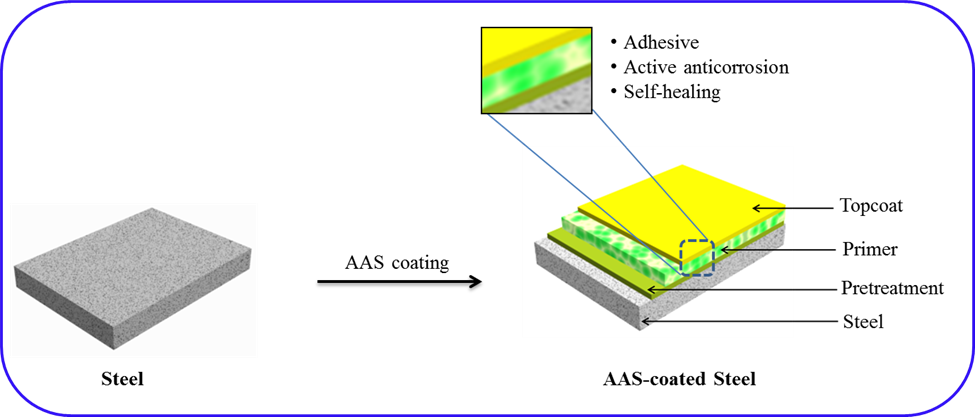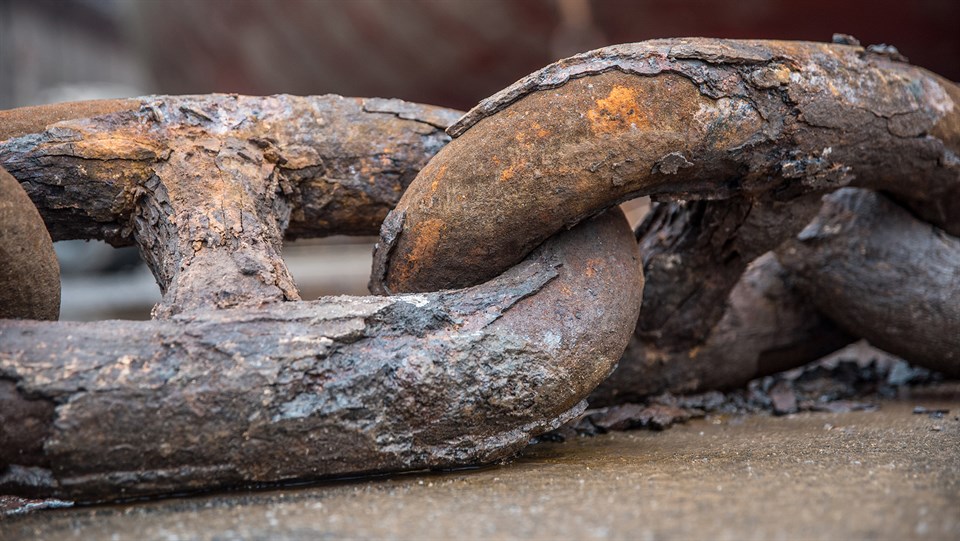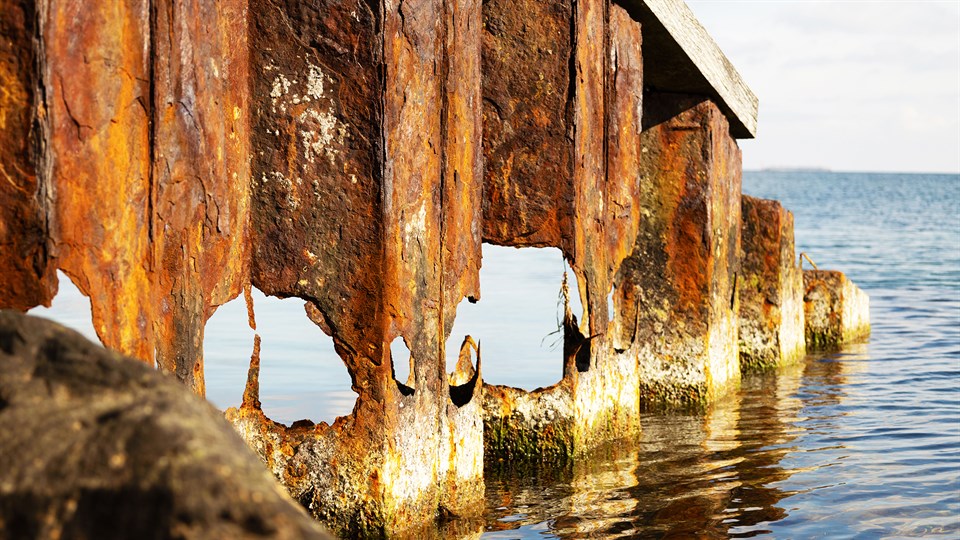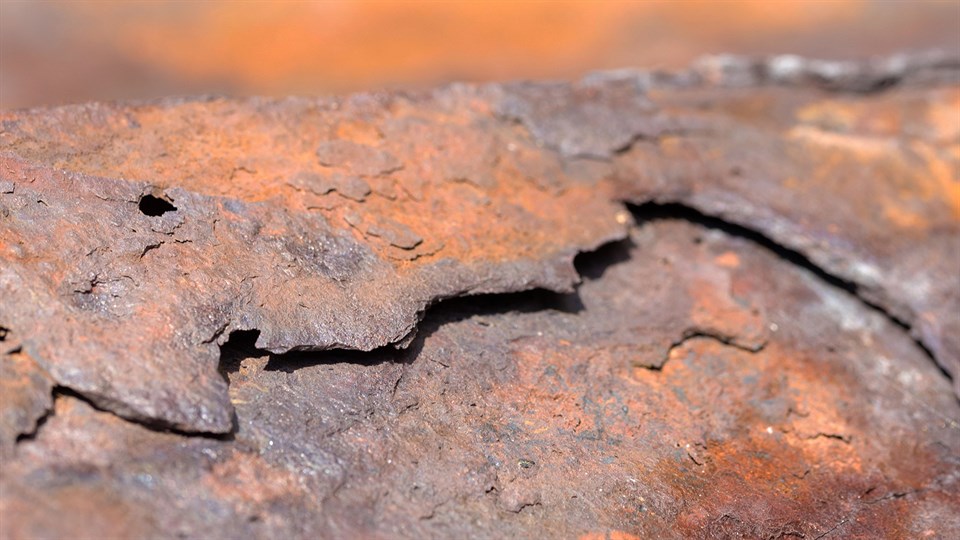Anti-corrosive coatings
Corrosion can lead to structure failures that have dramatic consequences for humans and surrounding environments. The use of anti-corrosive coatings is crucial when it comes to protecting metal constructions, such as pipelines, tunnels, ship ballast tanks, containers, and foundations of wind turbine, etc., against corrosion that occurs when the metal is exposed to i.e. chemicals for production purposes or to the harshest marine environments.
Fighting corrosion with high-tech anti-corrosive coating solutions
The objective of our research on anti-corrosive coatings is, through the characterisation of coating properties and coating performance evaluation, to get a better understanding of the coating protection and coating failure mechanism, therefore towards the advancement of more sustainable anti-corrosive coating development.
Current projects at CoaST incorporate electrochemical techniques as well as non-destructive surface/interface analysis techniques for coatings characterisation and coating performance evaluation. Both accelerated laboratory exposure and field testing are utilised. Through the mechanistic understanding of the coating degradation behaviour, we aim at the development of novel and more efficient anti-corrosive coating systems.
The research on anti-corrosive coatings at CoaST mainly covers:
- Novel/advanced anti-corrosive coating development
- Non-destructive coating performance evaluation
- Coating integrity management
Projects
Summary
The monopile, acts as the essential foundation for offshore wind turbines integrity, demanding effective corrosion mitigation strategies. Understanding environmental impacts on monopile corrosion and coating deterioration aids in devising an effective corrosion control strategy. The project aims to investigate environmental impacts on internal monopile corrosion and coating degradation, develop a new corrosion prevention technique, and implement real-time monopile monitoring.The project
Rising offshore wind power deployments harness consistent sea winds from the vast open areas. Steel monopiles are the primary choice for offshore wind foundations, while the harsh offshore conditions accelerate the deterioration of wind structures, resulting in faster corrosion rates and shortened lifespan. Cathodic protection as an anti-corrosion measure presents the advantage of the formation of calcareous deposits on the steel surface. Understanding the environmental factors affecting corrosion and the calcareous layer formation, as well as choosing effective corrosion mitigation strategies is crucial to guarantee the structural integrity of the monopile and enhance its service life.
The project aims to:
• Investigate-understand the environmental factors impacting internal monopile corrosion and coating degradation.
• Study the environmental factors affecting the formation of the protective calcareous deposits.
• Implement cathodic protection and organic coatings for the corrosion protection of the monopile.
• Study the optimal conditions for cathodic protection and the evolution of the calcareous layer.
• Utilize online monitoring methods for monopile corrosion and coating degradation.
• Compare the lab-scale results with real field exposure data. The expected research results are a better understanding of the environmental conditions impacting internal monopile corrosion and calcareous layer formation, establishing an efficient, feasible anti-corrosion method for current and future offshore wind turbines enhancing their lifespan, and its integration with an online monitoring system.
Funding
The Hempel Foundation and the Technical University of Denmark (DTU)
The project runs from 1 December 2022 - 31 March 2025.
Supervisors
- Kim Dam-Johansen
- Huichao Bi
Contact
Charalampos Belesakos PhD Student Department of Chemical and Biochemical Engineering charbel@kt.dtu.dk
Contact
Huichao (Teresa) Bi Associate Professor Department of Chemical and Biochemical Engineering Phone: +45 45252954 hubi@kt.dtu.dk
Summary
Zinc-rich epoxy (ZRE) coating is widely used for the heavy-duty corrosion protection of steel structures in industrial and marine environments. The protective ability of a ZRE coating is based on cathodic protection and subsequent barrier/inhibitive protection. Typically, a high zinc content (≥ 80 wt% in dry film) is essential to ensure high electrical conductivity for effective cathodic protection. However, only around one-third of the added zinc in a standard ZRE coating was found to contribute to cathodic protection. Moreover, such a high zinc content in coatings could cause problems such as weak adhesive and cohesive strength, poor mechanical properties, and in-can sedimentation. The project aims to synthesize zinc-containing materials that can be used in the coating to improve its anticorrosive properties and/or reduce the zinc content.
The project
• Zinc-containing particles with special properties are synthesized via a high-temperature process and used as substituents of zinc dust pigments in zinc-rich coatings
• The anticorrosion performance and electrochemical behavior of coatings are studied and auxiliary characterizations are performed to improve the mechanistic understandings.
• The study proposed a good strategy to improve the utilization efficiency of zinc in zinc-rich coatings, which enables a more effective use of zinc materials, reducing the zinc consumption.
Funding
The Hempel Foundation. The project runs from 1 January 2023 - 31 December 2023.
Supervisors
- Kim Dam-Johansen (main supervisor)
- Hao Wu (co-supervisor)
Contact
Contact
Kim Dam-Johansen Professor, Head of Department Department of Chemical and Biochemical Engineering KDJ@kt.dtu.dk
Objective
The aim of this project is to construct intelligent epoxy anti-corrosive coatings incorporating ultra-stable highly porous metal organic frameworks (MOTs) container for loading corrosion inhibitors.
The project
Smart anti-corrosion coatings have garnered significant attention in recent years due to their ability to provide long-lasting protection against corrosion. These coatings rely on the incorporation of corrosion inhibitors encapsulated in porous structures, highlighting the critical importance of designing efficient containers for loading these inhibitors. In order to maximize the effectiveness of these coatings, several key properties of containers must be carefully considered, including a high specific surface area, stimuli-responsive behavior, a simple synthesis procedure, and stability in acidic, basic and neutral environments. However, most existing containers lack at least one of these properties. Therefore, in this project, we aim to design advanced pigments based on ultra-stable and highly porous MOFs with all desired properties to construct a high-performance anti-corrosive coating.
Funding
The Hempel Foundation. The project runs from 15 March 2023 - 14 March 2026.
Supervisors
- Kim Dam-Johansen
- Huichao (Teresa) Bi
Contact
Mohammad Ghaderi PhD Student Department of Chemical and Biochemical Engineering mohgha@kt.dtu.dk
Contact
Huichao (Teresa) Bi Associate Professor Department of Chemical and Biochemical Engineering Phone: +45 45252954 hubi@kt.dtu.dk

Using energetic polymers and smart additives to develop multifunctional waterborne coatings for steel with strongly adhesive, active anticorrosion and self-healing properties.
Objective
The objective of this project is to develop a new robust multifunctional strongly adhesive to substrate, active anticorrosion and self-healing coating (AAS-coating) for steel. Through:
- Synthesizing active nanoparticles and self-healing microcapsules
- Synthesizing energetic polymers
- Developing new smart waterborne anticorrosion coatings
- Examining their active anticorrosion, self-healing and mechanical properties.
Background
Smart active and self-healing coatings have great potential particularly due to their autonomous response and healing of coating defect. Upon onset of corrosion, active components can respond to local environmental changes inhibiting corrosion propagation.
Moreover, the intrinsic self-healing polymers confer on the coating the property of automatically repairing microcracks in situ, improving protection during production, storage, transportation, and usage. However, the introduction of smart additives into waterborne anticorrosion coatings compromizes the integrity of the coating matrix by creating water uptake pathways, leading to delamination and other mechanical property failures.
The Project
Inert self-healing polymers do not contain energetic groups, thereby limiting the energy density of coatings and detrimentally affecting the efficiency of coating.
Therefore, we shall design a strongly adhesive waterborne coating, relying on loose hard domains, rapid rearrangement of hydrogen bonds, and strong interfacial adhesion of energetic polymers.
We combine that property with incorporating (i) active preloaded mesoporous nanoparticles, and (ii) impregnated microcapsule components to obtain coating with high adhesion, active anticorrosion, and self-healing properties.
Funding
The Hempel Foundation and the Technical University of Denmark (DTU)
The project runs from 1 August 2022 - 31 July 2024.
Supervisors
- Kim Dam-Johansen
Contact
Inime Ime Udoh Postdoc Department of Chemical and Biochemical Engineering inudoh@kt.dtu.dk
Contact
Kim Dam-Johansen Professor, Head of Department Department of Chemical and Biochemical Engineering KDJ@kt.dtu.dk
Summary
The project is on the fundamental understanding of the protection and degradation mechanism of anti-corrosive coatings and the key factors affecting the coating performance, thereby providing guidance to the coating formulation improvement.
The project
The results of corrosion and failure modes of coating protection are known and internalized by the academy and industry professionals. But the distinct mechanisms that led to those failure modes are not that clear.
For characterizing degradation of coatings, a holistic view is needed. Transport processes, chemical and physical changes on the coating structure, corrosion reaction itself all act on the coating and degradation is the combined result of the various competitive and synergic processes.
Anti-corrosive coating formulations, by their nature, take considerable time in development and especially testing. Knowing how the coating protects & fails and understanding the mechanism behind would provide significant guidance for the new coating formulation development and facilitate the coating performance improvement.
Funding
The Hempel Foundation and the Technical University of Denmark (DTU)
The project runs from 1 April 2023 to 31 March 2026
Supervisors
- Kim Dam-Johansen
- Huichao (Teresa) Bi
Contact
Mehmet Bengi Taysun PhD Student Department of Chemical and Biochemical Engineering mbeta@kt.dtu.dk
Contact
Huichao (Teresa) Bi Associate Professor Department of Chemical and Biochemical Engineering Phone: +45 45252954 hubi@kt.dtu.dk



